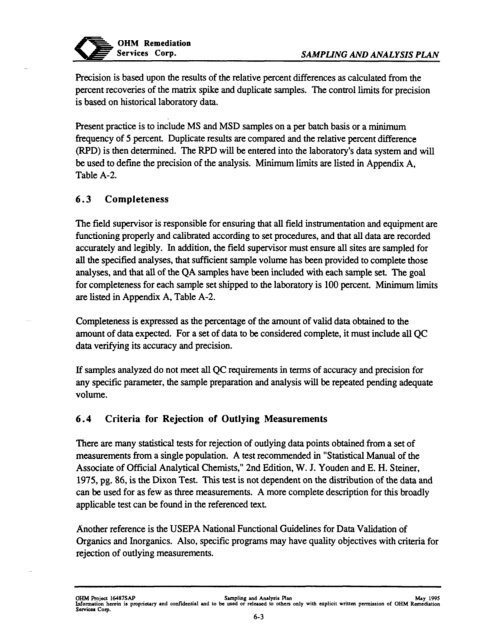work plan for soil remediation, sampling and analysis plan, site ...
work plan for soil remediation, sampling and analysis plan, site ...
work plan for soil remediation, sampling and analysis plan, site ...
You also want an ePaper? Increase the reach of your titles
YUMPU automatically turns print PDFs into web optimized ePapers that Google loves.
OHM RemediationServices Corp. SAMPLING AND ANALYSIS PLANPrecision is based upon the results of the relative percent differences as calculated from thepercent recoveries of the matrix spike <strong>and</strong> duplicate samples. The control limits <strong>for</strong> precisionis based on historical laboratory data.Present practice is to include MS <strong>and</strong> MSD samples on a per batch basis or a minimumfrequency of 5 percent, Duplicate results are compared <strong>and</strong> the relative percent difference(RPD) is then determined. The RPD will be entered into the laboratory’s data system <strong>and</strong> willbe used to define the precision of the <strong>analysis</strong>. Minimum limits are listed in Appendix A,Table A-2.6.3 CompletenessThe field supervisor is responsible <strong>for</strong> ensuring that all field instrumentation <strong>and</strong> equipment arefunctioning properly <strong>and</strong> calibrated according to set procedures, <strong>and</strong> that all data are recordedaccurately <strong>and</strong> legibly. In addition, the field supervisor must ensure all <strong>site</strong>s are sampled <strong>for</strong>all the specified analyses, that sufficient sample volume has been provided to complete thoseanalyses, <strong>and</strong> that all of the QA samples have been included with each sample set. The goal<strong>for</strong> completeness <strong>for</strong> each sample set shipped to the laboratory is 100 percent. Minimum limitsare listed in Appendix A, Table A-2.Completeness is expressed as the percentage of the amount of valid data obtained to theamount of data expected. For a set of data to be considered complete, it must include all QCdata verifying its accuracy <strong>and</strong> precision.If samples analyzed do not meet all QC requirements in terms of accuracy <strong>and</strong> precision <strong>for</strong>any specific parameter, the sample preparation <strong>and</strong> <strong>analysis</strong> will be repeated pending adequatevolume.6.4 Criteria <strong>for</strong> Rejection of Outlying MeasurementsThere are many statistical tests <strong>for</strong> rejection of outlying data points obtained from a set ofmeasurements from a single population. A test recommended in “Statistical Manual of theAssociate of Official Analytical Chemists,” 2nd Edition, W. J. Youden <strong>and</strong> E. H. Steiner,1975, pg. 86, is the Dixon Test. This test is not dependent on the distribution of the data <strong>and</strong>can be used <strong>for</strong> as few as three measurements. A more complete description <strong>for</strong> this broadlyapplicable test can be found in the referenced text.Another reference is the USEPA National Functional Guidelines <strong>for</strong> Data Validation ofGrganics <strong>and</strong> Inorganics. Also, specific programs may have quality objectives with criteria <strong>for</strong>rejection of outlying measurements.OHM Project 16487SAP Sampling <strong>and</strong> Analysis Plan May 1995I&&ti~o$;rein is proprietary <strong>and</strong> confidential <strong>and</strong> to be used or relcsscd to others only with explicit written permission of OHM Ranediation6-3
















